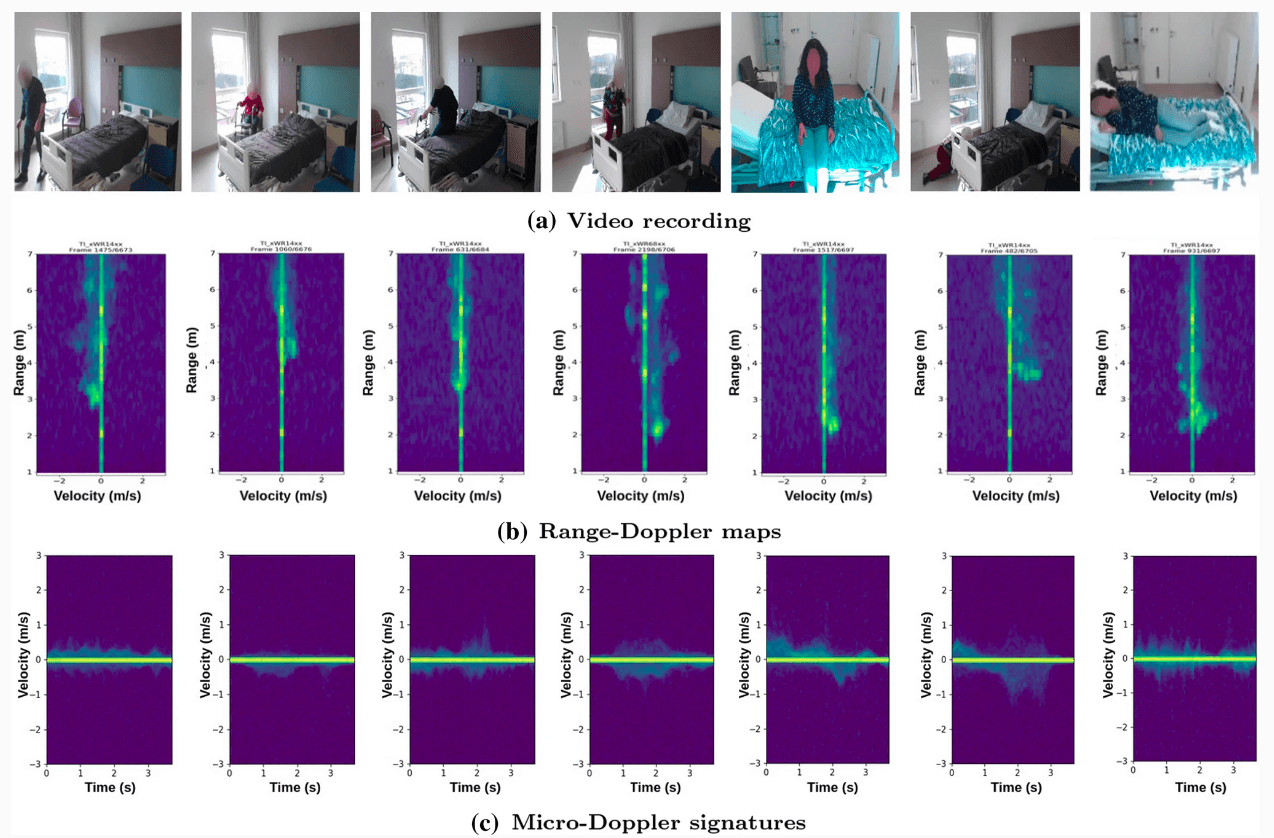PARrad
A dataset for Patient Activity Recognition using Radar Sensors
Introduction
Healthcare systems of today are facing two serious challenges: the rapid growth of the elderly population and a severe shortage of medical practitioners. Nowadays, patients are increasingly monitored using devices ranging from various medical sensors to typical Internet of Things (IoT) sensors. Indoor human activity recognition is one of the vital aspects of many intelligent surveillance systems ranging from smart homes to patient health monitoring tools. These surveillance systems commonly use video cameras as their primary sensors. Video-based surveillance systems have advantages such as wide viewing angles, high-definition resolution, and cost-effectiveness. However, they show fundamental deficiencies such as being inefficient in poor weather and low-light environments, more difficult to detect subjects with concealing clothes, etc. Moreover, video-based sensors are intrusive, and may not be a feasible choice where privacy plays an important role. In contrast, radar devices can operate in a variety of severe conditions such as rain, fog, dust, darkness, smoke, and heat. Further, radar devices are privacy-preserving and non-intrusive in their nature which facilitate their usage in environments with a high privacy demand. In addition, they are capable of sensing through the walls or any other obstructing elements. These qualities of the radar sensors make them a logical choice for indoor human activity recognition where privacy plays a significant role. Hence, modern and compact radar sensors are an interesting option as an alternative to video cameras in many applications today.
Human activity recognition provides support to healthcare by monitoring daily activities of patients and elderly people to detect critical events such as fall, change in behavior, physical fitness, etc. Monitoring of human activities is commonly tackled by various technologies such as video cameras and wearable sensors. However, the use of such sensors shows various fundamental deficiencies and privacy issues. In contrast, radars ensure comfort by their contact-less and non-intrusive properties. Moreover, radar sensors are unaffected by low-light conditions, can sense through concealing objects and also maintain privacy.
We investigated a novel approach towards automatic indoor human activity recognition for patient activities in a hospital setting, using deep neural networks for processing high-dimensional radar data. To that end, we constructed and published the data set in the paper Bhavanasi et al.[1]. More information on our team can be found at https://sumo.intec.ugent.be. A complete overview of this work can be found in our published paper:
[1] Bhavanasi, G., Werthen-Brabants, L., Dhaene, T. et al. Patient activity recognition using radar sensors and machine learning. Neural Computing & Applications (2022). https://doi.org/10.1007/s00521-022-07229-x
Summary
To facilitate further research, we developed Patient Activity Recognition with Radar sensors (PARrad) data set. The PARrad data set was constructed using two Frequency Modulated Continuous Wave (FMCW) radars with a center frequency of 77GHz and 60GHz, in two different types of environments: a synthetic hospital room (Homelab) and a real-life hospital room (Hospital). In Figure 1, different signatures produced by radar sensors are shown, with accompanying activities and images. In total the data set contains 21569 activities, subdivided into 8210 Homelab activities and 13359 Hospital activities. Our data set thus contains a total of 22 hours of effectively annotated activity data distributed over 14 classes. Furthermore, in Hospital data, we have adult people, elderly people, with mobility aids (walking stick and walker) and without mobility aids. Whereas, in Homelab data, we have only adult people without mobility aids. We released a PARrad data set containing 22 hours of data of 24 subjects performing various tasks in a hospital room setting.

Figure 1: Radar data of different activities labelled as: walk to room, sit down on chair, get in bed, walk to bed, sit down on bed, fall on the floor and roll in bed. Image courtesy of Bhavanasi et al.
Download
The data set is available in full, or as subjects separately. A README includes technical information. The same data set is also made available for download on our website at https://sumo.intec.ugent.be/parrad. Please cite our data set as follows:
@article{bhavanasi2022patient,
title ={Patient activity recognition using radar sensors and machine learning},
author={Bhavanasi, Geethika and Werthen-Brabants, Lorin and Dhaene, Tom and Couckuyt, Ivo},
journal={Neural Computing and Applications},
pages={1--16},
year={2022},
publisher={Springer},
url={http://dx.doi.org/10.1007/s00521-022-07229-x}}
